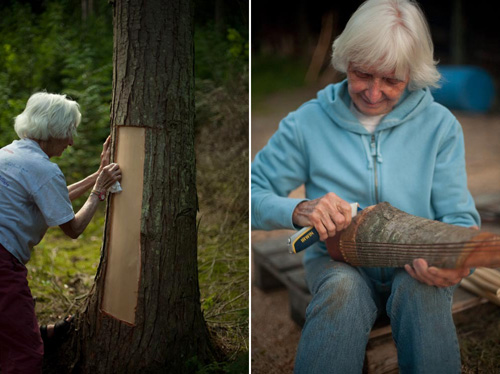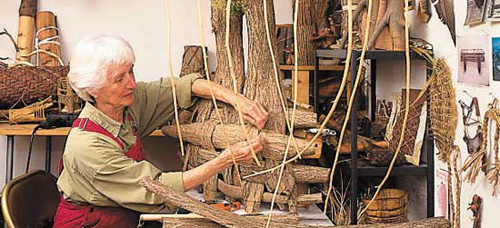Each year, Penland School of Crafts chooses one of its instructors as that year’s Outstanding Artist Educator, in honor of extraordinary contributions to the craft world, as both artist and teacher. The Outstanding Artist Educator is celebrated as a part of our annual benefit auction. This year’s honoree is Dorothy Gill Barnes.

We asked writer and artist Eva Tuschman, who has been a student of Dorothy’s, to share her thoughts about her teacher. She went a step beyond our expectations, and conducted an in interview with Dorothy as well:
“In the summer of 2010 I had the opportunity to return to Penland to study with the spirited craftswoman, Dorothy Gill Barnes, whose sculptural work, spanning over 6 decades, responds to materials and forms found in nature. It was difficult to keep pace with sprightly Dorothy as she scampered up muddy hillsides in the rain, clutching an axe, eager to hack into a fallen cedar and peel away a 40-foot long segment of bark. Her self-ignited curiosity to explore materials proved insatiable. I had never met someone whose inner drive to solve answers to her own self-generated questions kept her constantly moving from dawn till dusk. The week of our workshop, Dorothy celebrated her 83rd birthday. She showed up to her own birthday party — ready to drink beer and eat pie – in her “fancy overalls” and a hat she fashioned herself out of bark and twine. While Dorothy often exhibited more physical agility and stamina than her younger students, what inspired me most was the way her creative practice, and the energy it galvanized, fueled her life; the two processes were inextricable.
“Just as a bird gathers fibers to build its nest, or bees instinctually know the patterns to construct their hives, Dorothy’s relationship to natural materials, from harvesting bark to weaving it into sculptural baskets, seems entirely intuitive. Dorothy was born to be a maker. Her life’s work embodies an expression of reverence for the natural world—its forms and textures, an ongoing dialogue with its lines and structures. One could say Dorothy is the Mary Oliver of the craft world: a poet whose words take the form of bark curling off a limb, or the gentle shaping of tree skin around a stone. Each piece is a poem, an object that invites us to pause and settle our attention, with delight and gratitude for what her hands have touched.

“While Dorothy is a formal educator of over six decades, who can be found teaching preschoolers in inner city classrooms, college students and elders, it is her modeling of curiosity—her devotion to exploration and experiment — and the inseparability of her creative inquiry with her life itself that teaches us the most about how to live.
“Graciously, Dorothy agreed to sit down with me one evening at Penland to have a conversation about her life and career, early inspiration, and reflections on the natural world, creativity, and arts education:”
Eva: What are some of your earliest memories of encountering the natural world and collaborating with nature?
Dorothy Gill Barnes: As I think back it would be in Strawberry Point, Iowa when I was a little girl and it would be in my own back yard. There was a place down at the corner of our fence near the cornfields. All the houses were close together like in a small town—though it wasn’t congested. I used to go down and sit under a tree, past where we fed the chickens, and it was a special place because no one was around me. I spent time looking at the ground and played in the tree roots. I made little places where I could dig and put my toys. I played in the asparagus bed with my sister….I liked seeing what water would do in a stream….I was lining things up and seeing how beautiful they were and putting things together, like little stones of a certain size, and it was my play.
Eva: Did you always see yourself as a maker? Or was there a particular point in your development when you realized this was who you were?
Dorothy: I think from the very beginning, from being a little girl, I never questioned what I was going to do. I just knew I was going to play with cloth and paper—filling up little cod-fish boxes… I didn’t read very well and a lot of my friends were readers and I would just be so happy if I could read one book all summer! I was so embarrassed that I didn’t read books like my friends did, but I was active: I rode my bicycle. When I had time to do something creative, it didn’t include reading or writing, although I did write some poems, which were terrible! I just thought they were fun and funny! Mostly I created things; cardboard boxes were just a dream material for me. I loved working with boxes.
Eva: How do you see the relationship between creativity and nature?
Dorothy: I think that nature is so incredibly wonderful. I think probably because I lost my mother and two sisters early, I always felt so fortunate to be out healthy, doing things and enjoying nature, looking at things, always, the variety, night and day, weather and flowers and animals scurrying… I think the thing that was neat about bringing art and nature together was that you could be outdoors and you didn’t have to be limited indoors. What made me feel better about things that didn’t happen well in my life seemed to be nature. And my favorite author is Mary….oh, it will come to me…Mary?
Eva: Mary Oliver?
Dorothy: Yes, of course! If I read a Mary Oliver poem I like I just really enjoy that a lot. I have her books laying around the house. I do read poetry a lot.
Eva: The other day you mentioned something about gratitude being part of your art practice. I wonder if you can talk a little bit more about that….working with trees and bark, the things which are given from nature….I know Mary Oliver speaks about reverence and a sense of wonder…Is this a part of your process?
Dorothy: I think those words you just said are really lovely. It’s exciting to me to hear someone use words, which make a difference, which mention making mistakes, which is a part of life. I think justice and reverence are the two words, which I recently heard a man use—I don’t even remember his name—being interviewed by Charlie Rose. Justice and reverence. If you think about those two words and about where they go, in current events and worldwide, when they are beautiful and when they are troubled…those are two good words to remember.
Eva: The other day you mentioned the book, The Last Child in The Woods. It seems a big problem that some children are not exposed to nature and do not feel comfortable there. I wonder if you think this affects their ability to be creative.
Dorothy: …Yes, definitely. There are many reasons people should be outdoors more… However, I am a little hesitant about the over-organization of such things. I can’t imagine as a child, for example, being signed up for art classes. I think it can be wonderful to have paper and supplies, but when I see the amount of stuff that children have when they are young, I wonder if it is really a good idea. I sometimes think just a blackboard or a sidewalk can be enough. Those temporary marks that you make are very important. You do them when you want to do them, not when a teacher tells you to…. I think more leisure time when don’t really know why you’re going outside, just to be alone…. I think out in the woods is a really good place to be! Freedom to do what you want to do when you want to do it! If you want to climb a tree, climb a tree!
– Eva Tuschman



